Introduction: Gena Philibert-Ortega is a genealogist and author of the book “From the Family Kitchen.” In this blog post, Gena searches old newspapers to find stories about the history of fireworks and their use for celebrations in America.
With the recent Fourth of July celebrations for Independence Day in America, we all have been seeing and hearing a lot of fireworks lately.
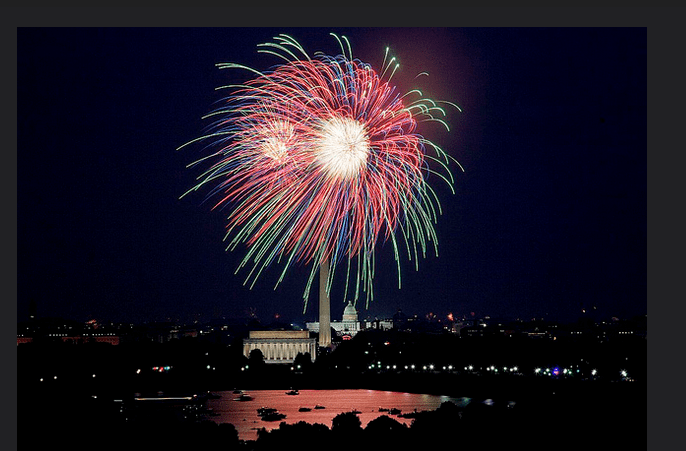
Letter from John Adams
It seems that the idea to celebrate our nation’s independence has always included fireworks. In a 3 July 1776 letter to his wife Abigail, future President John Adams declared:
The Second Day of July 1776, will be the most memorable Epocha, in the History of America. I am apt to believe that it will be celebrated, by succeeding Generations, as the great anniversary Festival. It ought to be commemorated, as the Day of Deliverance by solemn Acts of Devotion to God Almighty. It ought to be solemnized with Pomp and Parade, with Shews, Games, Sports, Guns, Bells, Bonfires and Illuminations from one End of this Continent to the other from this Time forward forever more.*
(Note: Adams was referring to the unanimous vote by the Continental Congress on 2 July 1776 in support of a resolution of independence from Great Britain. The formal Declaration of Independence was ratified 4 July 1776, which is why we celebrate Independence Day on the Fourth of July.)
Adams’ letter was reprinted in various newspapers well into the 19th century. It was even recalled in this 1893 California advertisement which proclaims: “Boys, how are you going to celebrate the glorious Fourth? With Fireworks of course, like true and patriotic little Americans.” Adams’ letter ran across the top of the ad, above a cartoon of Uncle Sam handing fireworks to little boys, promising them a supply of fireworks “with every Boy’s Suit sold in the Juvenile Department, no matter what price suit it may be.” More than one company used the award of fireworks as a motivator to get kids to sell or buy their product.
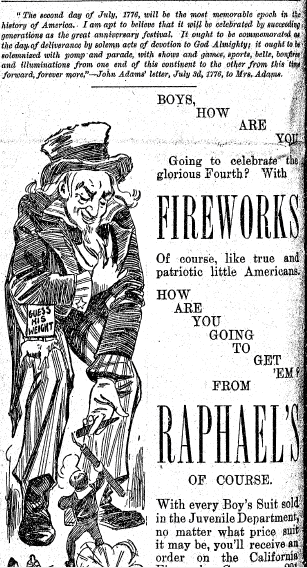
While we celebrate the 4th of July and not the 2nd as stated in Adams’ letter, the spirit is still the same: revelries including fireworks are all part of the holiday festivities.
The History of Fireworks
The history of fireworks predates those first July celebrations here in the United States of America. Most historians believe that fireworks originated in China prior to 1000 A.D., when bamboo would be heated until it exploded. Fireworks evolved to include ingredients used for gunpowder.** No matter when they were actually discovered, fireworks have long been a part of various celebrations in the United States.
Do you think that our ancestors had plain, not-so-exciting fireworks? Well you would be wrong. Fireworks makers have always been creative. Consider this 1901 newspaper article’s description of fireworks: balloon fireworks that, when released into the air, pop and leave behind
elephants and fish and as many animals as Noah had in the ark to float around, with rockets and roman candles shooting out of them. They can be bought with attachments which will make music too.
This old newspaper article further describes fireworks
rising like the Eiffel tower of fire to an immense height, with a grand explosion, from a gorgeous veil of feathery plumes reaching nearly to the ground, embellished with topaz and emerald comets intertwining in their flight. Amid the clouds they display a broad, swelling spread of liquid gold in streamers of glittering radiance, with feathery edges gradually spreading and dissolving into a cloud of sparkling mist. Bursting in midheaven, they form an aurora…shower of electric jewels of emeralds and sapphire tints falling slowly to the earth.
What a great fireworks show!
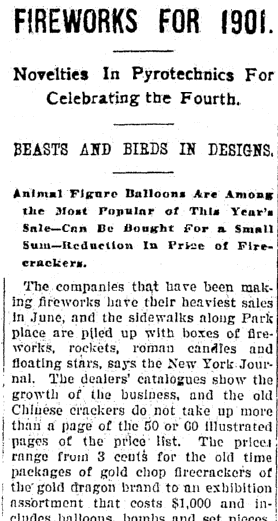
Explosive Danger
There’s no doubt fireworks are dangerous. Reading late 19th and early 20th century newspapers, it becomes clear that some of the concerns still held today by city officials and firefighters existed during our ancestors’ time. While the dangers of fireworks are many—everything from the manufacture to the handling, storage and subsequent igniting of the device—fireworks have been known to result in fires, injuries, and even death.
Because of this associated danger, various laws including the banning of displays have been a part of fireworks history in the United States. Even in my lifetime, here in California we have gone from setting off fireworks in our driveways, to fireworks being banned for individual sale, to municipalities cancelling fireworks displays because of budget shortfalls and drought conditions. Reading through historical newspapers, it seems that life hasn’t changed too much.
Consider this newspaper article about an explosion at a fireworks factory in 1904. The explosion killed three people and injured six.
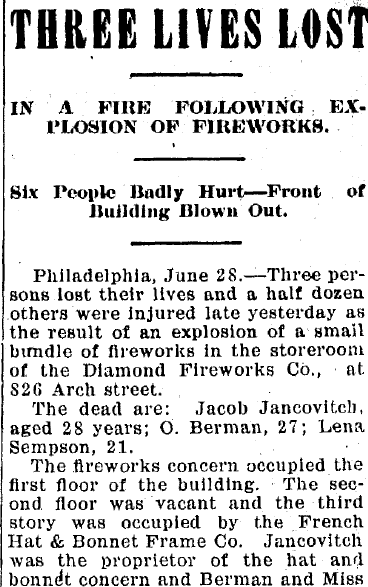
While the explosion occurred on the building’s first floor where the fireworks factory was located, two of the victims killed were actually working on the third floor for a hat company. A newspaper article appearing a few days later provided information from the coroner’s inquest including drawings of some of the witnesses.
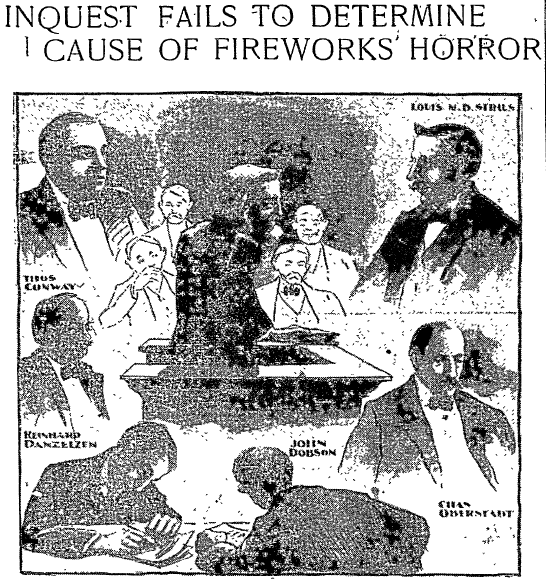
Fireworks Aren’t Just for the 4th of July
While fireworks are probably most associated with the Fourth of July, then as now they are set off for other celebratory occasions or events. State fairs, amusements parks and baseball stadiums all use fireworks as a way to make a day out more memorable.
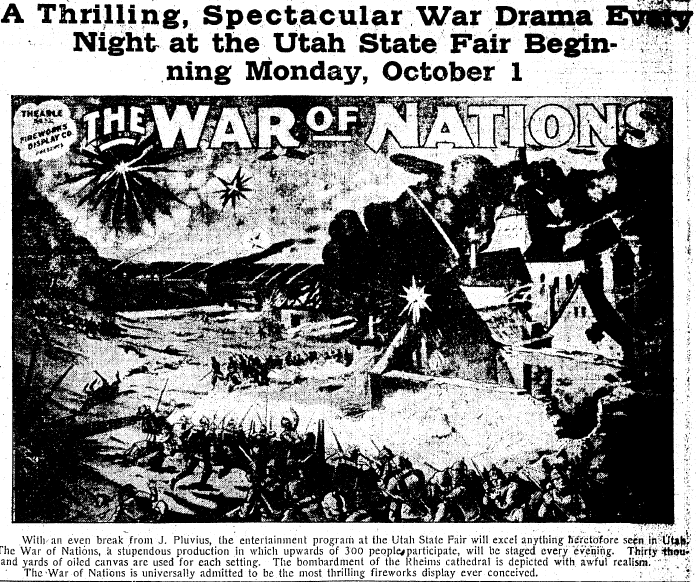
Our ancestors even used fireworks to commemorate Christmas. In this advertisement for Christmas trees, fireworks feature prominently—a combination many of us would find odd today.
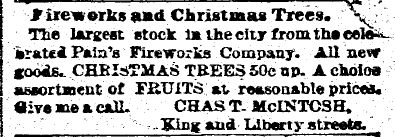
Fireworks have helped us celebrate occasions throughout our country’s history. Read more about how your ancestor’s hometown celebrations played out by searching in GenealogyBank’s Historical Newspaper Archives.
_________
*From the National Park Service webpage “National Mall Independence Day Celebration” at http://www.nps.gov/foju/historyandculture.htm. Accessed 2 July 2014.
**From the A&E History webpage “Fireworks’ Vibrant History” by Jennie Cohen at http://www.history.com/news/fireworks-vibrant-history. Accessed 2 July 2014.
[bottom_post_ad]
